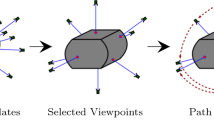Abstract
Object recognition is imperative in industry automation since it empowers robots with the perceptual capability of understanding the three-dimensional(3-D) environment by means of sensory devices. Considering object recognition as a mapping between object models and a partial description of an object, this paper introduces a three-phase filtering method that eliminates candidate models when their differences with the object show up. Throughout the process, a view-insensitive modeling method, namely localized surface parameters, is employed.
Surface matching is carried out in the first phase to match modelswith the object by comparing their localized surface descriptions. Amodel is a candidate of the object only if every object surfacematches locally with at least one of the model surfaces. Since thetopological relationship between surfaces specifies the global shapeof the object and models, it is then checked in the next phase withlocal coordinate systems to make sure that a candidate model has theidentical structure as the object.
Because the information of an object cannot be complete in a singleviewing direction, the first two conditions can only determine if acandidate has the same portion as the object. The selected model maystill be bigger than the object. To avoid the part-to-wholeconfusion, in the third phase, a back projection from candidatemodels is performed to ensure that no unmatched model features becomevisible when a model is virtually brought to the object‘sorientation.
In case multiple models are selected as a result of the insufficientinformation, disambiguating features and their visible directionsare derived to verify the expected feature. In addition to the viewindependent object recognition under even ambiguous situations, thefiltering method has a low computational complexity upper bounded byO (m 2 n 2) and lower bounded by O(mn),ssswhere m and n are the numbers of model and object features. The three-phase objectrecognition has been exercised with real and synthesized rangeimages. Experiment results are given in the paper.
Similar content being viewed by others
References
F. Arman and J.K. Aggarwal, "Model-based object recognition in dense-range images—A review" Computing Surveys, Vol. 25, No.1, pp. 5–43, 1993.
P.J. Besl, Surfaces in Range Image Understanding, Springer-Verlag: New York, 1988.
P.J. Besl, "The free-form surface matching problem," in Machine Vision for Three-Dimensional Scenes, Academic Press, Inc., pp. 25–72, 1990.
P.J. Besl and R.C. Jain, "Three-dimensional object recognition," Computing Surveys, Vol. 17, No.1, pp. 75–145, 1985.
R.M. Bolle and B.C. Vemuri, "On three-dimensional surface reconstruction method," IEEE transactions on Pattern Analysis and Machine Intelligence, Vol. 13, No.1, pp. 1–13, 1991.
H. Bunke and T. Glauser, "Viewpoint independent representation and recognition of polygonal faces in 3-D," IEEE Transactions on Robotics and Automation, Vol. 9, No.4, pp. 457–463, 1993.
J.B. Burns, R.S. Weiss, and E.M. Riseman, "View variation of point-set and line-segment features," IEEE Transactions on Pattern Analysis and Machine Intelligence, Vol. 15, No.1, pp. 51–68, 1993.
R. Chellappa and A. Rosenfeld, "Current issues in computer vision," Sadhana-Academy Proceedings in Engineering Sciences, Vol. 18, pp. 149–158, 1993.
J.J. Craig, Introduction to Robotics: Mechanics & Control, Addison-Wesley: Reading, Massachusetts, second edition, 1989.
J.L. Crowley and F. Ramparany, "Mathematical tools for representing uncertainty in perception," in Spatial Reasoning and Multi-sensor Fusion: Proceeding of the 1987 Workshop, Academic Press: New York, 1987, pp. 293–302.
T. Fan, Describing and Recognizing 3D Objects Using Surface Properties, Springer-Verlag, 1990.
M. Fischler and O. Firschein, Intelligence: The Eye, The Brain, and The Computer, Addison Wesley, 1987.
J. Foley et al., Computer Graphics: Principles and Practice, Addison Wesley, second edition, 1992.
N. Ford, Expert Systems and Artificial Intelligence, Library Associate Publishing, 1991.
W.B. Green, Digital Image Processing: A Systems Approach, Van Nostrand Reinhold: New York, second edition, 1989.
S.G. Hoggar, Mathematics for Computer Graphics, Cambridge University Press, 1992.
R. Jain and A.K. Jain, Report: 1988 NSF range image understanding workshop, in Analysis and Interpretation of Range Images, Springer-Verlag, N.Y., 1990, Chapter 1, pp. 1–32.
G.F. Luger and W.A. Stubblefield, Artificial Intelligence and the Design of Expert Systems, The Benjamin/Cummings Publishing Company, 1989.
M. Magee and M. Nathon, "Spatial reasoning, sensor repositioning and disambiguation in 3D model based recognition," in Spatial Reasoning and Multi-sensor Fusion: Proceeding of the 1987 Workshop, Academic Press, 1987, pp. 262–271.
M. Magee and M. Nathon, "Viewpoint independent modeling approach to object recognition," Journal of Robotics and Automation, Vol. RA.3, No.4, pp. 351–356, 1987.
M. Mantyla, An Introduction to Solid Modeling, Computer Science Press, 1988.
James D. McCafferty, Human and Machine Vision: Computing Perceptual Organization, Ellis Horwood, 1990.
V.S. Nalwa, A Guided Tour of Computer Vision, Addison Wesley, 1993.
A. Rosenfeld, "Image-analysis and computer vision—1992," CVGIP-Image Understanding, Vol. 58, No.1, pp. 85–135, 1993.
R. Smith, M. Self, and P. Cheeseman, "Uncertain geometry in robotics," in Proceedings of the International Conference on Robotics and Automation, pp. 850–856, 1987.
I. Weiss, "Geometric invariants and object recognition," International Journal of Computer Vision, Vol. 10, No.3, pp. 207–231, 1993.
A.K.C. Wong and S.W. Lu, "Recognition and shape synthesis of 3D objects based on attributed hypergraphs," IEEE Transactions on Pattern Analysis and Machine Intelligence, Vol. 11, No.3, pp. 279–290, 1989.
X. Yuan, "LSP: A view insensitive 3D representation method," in Proceedings of Vision Interface ’93, Toronto, Ontario, 1993, pp. 64–69.
X. Yuan, "A mechanism of automatic 3D object modeling," IEEE Transactions on Pattern Analysis and Machine Intelligence, Vol. 17, No.3, pp. 307–311, 1995.
Author information
Authors and Affiliations
Rights and permissions
About this article
Cite this article
Yuan, X., Lu, S. Feature Mapping and View Planning with Localized Surface Parameters. Journal of Mathematical Imaging and Vision 7, 163–174 (1997). https://doi.org/10.1023/A:1008257622791
Issue Date:
DOI: https://doi.org/10.1023/A:1008257622791




